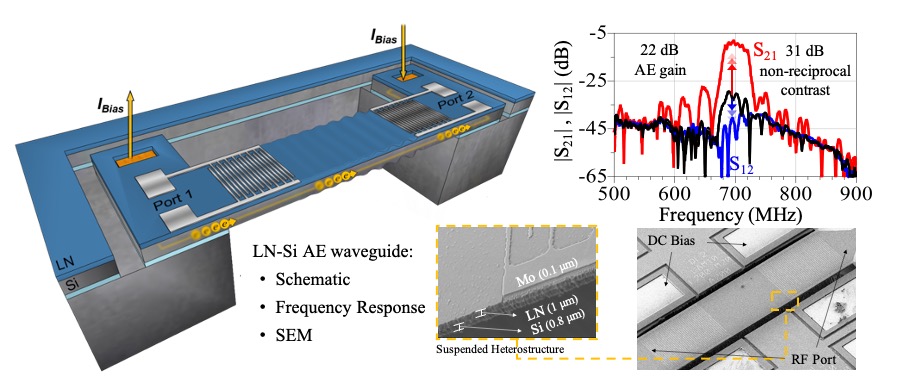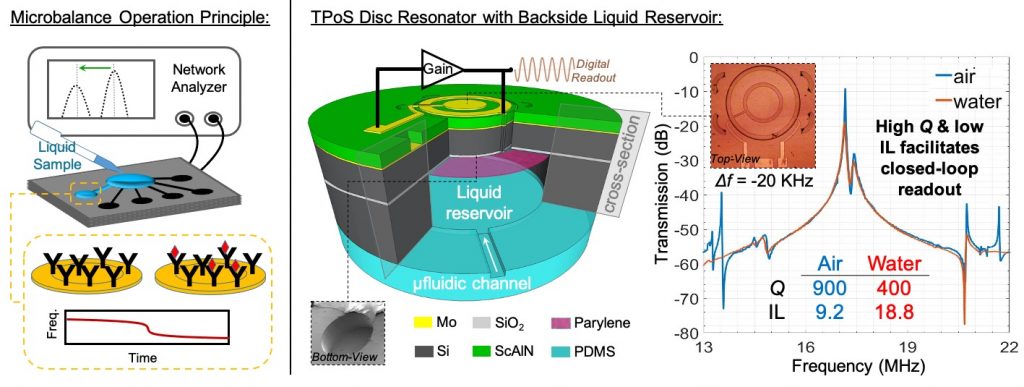Acoustoelectric Effect in Lamb Mode Composite Microdevices
We utilize the interaction between the mechanical (phonons) and electrical (electrons) domains in the micro scale to create efficient RF components based on the acoustoelectric (AE) phenomena. Taking advantage of high electromechanical coupling piezoelectric-semiconductor thin films we aim to revitalize the historically sought-after AE devices for applications in telecommunication and signal processing. By injecting ultrasonic electrons and exciting Lamb waves in such heterostructures, the acoustic wave, i.e. signal, is modulated by the injected electrons and fascinating features such as ~passive gain and non-reciprocity are attained. We have shown promising results in lithium niobate-on-silicon platform with AE gains above 20 dB and non-reciprocal contrasts of above 30 dB. This would facilitate the realization of the upcoming generations of telecommunications, stay tuned for more groundbreaking demonstrations.

Liquid-Phase Mass-Sensing with TPoS Resonators
MEMS microbalances generally cannot operate in liquid media, despite numerous applications that involve liquids. This is due to the irreversible leakage of the energy into the liquid which degrades the signal to noise ratio to the extent which readout is not possible. We utilize the TPoS platform along with a proper liquid isolation technique (using ultra thin Parylene-C films) to engineer low loss and high Q resonators for high resolution and low power liquid-sensing applications. We have preliminarily implemented our liquid-compatible TPoS disc resonators in basic oscillator circuits and achieved pico-scale resolutions with as low as ~2 mW power consumption. We are currently investigating the integration of our reliable platform with cells-on-chip to demonstrate real-time sensing of cell growth, stay tuned.

TPoS Acoustically-Coupled Filters
By coupling two or more acoustic modes in a single TPoS cavity, acoustically-coupled filters are realized. A 37th order filter with a low insertion loss of 3.7 dB and high rejection of 34 dB can be seen which is ideal for narrow bandwidth closely spaced RF communication frequency bands.

Thin-Film Piezoelectric-on-Substrate (TPoS) Resonators
As mobile electronics industry pushes forward, their products demand lower power, smaller components, and greater integration. To help achieve these goals, high-Q micromachined resonators provide an avenue to bring low-power oscillators, sensors, and multi-modal filters on chip. Recently, thin-film piezoelectric-on-substrate (TPoS) resonators have proved to offer low motional impedances with high Q in air and excellent linearity (high power handling). In these resonators, the piezoelectric layer drives and senses the vibration of a resonant body formed from the substrate. For the lateral-mode resonator lateral dimensions of the device (defined by lithography) determine the resonant frequency. At higher frequencies, the acoustic wavelength decreases; forcing the device features (width) to become excessively small, and consequently causing the motional impedance to rise. To compensate for the scaled transduction area, larger device lengths or higher order modes can be utilized. This will increase the overall resonant structure size allowing for a greater transduction area and electromechanical coupling. We are also passionate about the sources of loss in these devices and carefully watch them! Our renowned in-plane acoustic reflectors for mitigating one of the main sources of loss, i.e. anchor loss, can be seen in the figure below.

